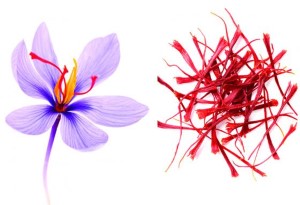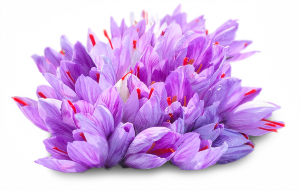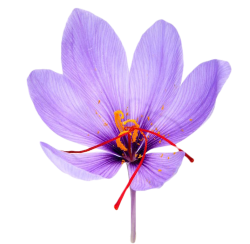Saffron plants
Saffron is a perennial plant that has bulbs with brown pods. this plant grows in southwest Asia. southern Spain and southern Europe. The saffron flower consists of a stem, six purple petals and three strand of red stigma of its flower. Saffron stigma contains fat, mineral salts and mucilage. Propagation of saffron is common only by underground corms. the aroma of saffron is due to the presence of a colorless essential oil containing tropene and an oxygenated compound with cineol called safranal. the taste of saffron is related to bitter heteroside picrocrocin. the color of saffron is related to the presence of a substance called crocin. Saffron is a valuable food that is obtained in small amounts from the saffron plant. in fact from every 100 to 200 thousand saffron plants, about 5 kilograms of saffron flowers are obtained, and after drying, its weight is reduced to one kilogram.
Nutritional value of Saffron
Saffron is a natural food coloring and seasoning that reduces blood fat and cholesterol. Saffron is soothing, appetizing, antispasmodic, prevents heart diseases and cancer, strengthens memory and lowers blood pressure.the saffron plant is used in the treatment of asthma, skin diseases, eye diseases, urinary infection, jaundice, delaying menstruation, removing flatulence, treating stomachache and treating anemia. Saffron helps digestion and strengthens the stomach and is used as a pain reliever, especially for gum pain.
Storage of Saffron
Saffron should be kept away from light and moisture and in closed glass or metal containers. Note that in the vicinity of humidity, the aroma of saffron gradually decresases, and if the lid of the saffron container is left open, its medicinal effects and quality will also decrease.
Type of Iranian Saffron
Negin: it is a type of saffron that is longer and thicker than normal saffron. this saffron also has the highest amount of aroma, taste and color among other types.
Sargol or All red : this type of saffron is pure and has a stigma without cream and has a very high coloring power.
Pushal: Pushal Sargol is hybrid that produces saffron that is longer and thicker than normal saffron.
Bunch: this type of saffron consists of yellow and red parts. in fact , bunch saffron contains a stigma.
Kanj or Style: the yellow or white parts separated from the red parts are saffron.
Abivard
Abivard is the old name of Dergaz city located in the northeast of iran in Razavi Khorasan province has always been and is the birthplace of saffron in the word, therefore, in order to preserve the prestige and status of Iranian saffron, Abivard Red Ruby Company with Abivard brand is trying to have a special share in the domestic and foreign markets with the use of experienced and young staff. Abivard With 10 years of working experience in the field of cultivation, wholesale and retail sale of saffron and having excellent interaction with farmers and producers of saffron by eliminating intermediaries and directly supplying the product in various ways, has removed intermediaries. Abivard Red Ruby Food Industry Group, with the approach of increasing he quality of its products, succeeded in obtaining the ISO9001 certificate in quality managment and always trying to take steps to reach global markets by considering customer satisfaction and complying with quality requirements.


